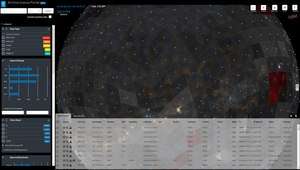Astronomical catalog

An astronomical catalog or catalogue is a list or tabulation of astronomical objects, typically grouped together because they share a common type, morphology, origin, means of detection, or method of discovery. Astronomical catalogs are usually the result of an astronomical survey of some kind.
Catalogs of historical importance
- Azophi's Book of Fixed Stars, published in 964, describes more than a thousand stars in detail and provides the first descriptions of the Andromeda Galaxy[2] and the Large Magellanic Cloud.[3][4]
- Johann Bayer's Uranometria star atlas was published in 1603 with over 1200 stars. Names are made of Greek letters combined with constellation name, for example Alpha Centauri.
- John Flamsteed's Historia coelestis Britannica star atlas, published in 1725, lists stars using numbers combined with constellation and ordered by right ascension, for example 61 Cygni.
- Messier Catalog - The Messier objects are a set of astronomical objects first listed by French astronomer Charles Messier in 1771. Nebulae and Star Clusters was published in 1781, with objects M1 – M110.
- New General Catalogue compiled in the 1880s by J. L. E. Dreyer, lists objects NGC 0001 – NGC 7840. The NGC is one of the largest comprehensive catalogues, as it includes all types of deep space objects and is not confined to, for example, galaxies.
- Henry Draper Catalogue published between 1918 and 1924, lists more than 225,000 of the brightest stars, named using HD followed by a 6-digit number.
- Sir Patrick Moore compiled the Caldwell catalogue in 1995 to complement the Messier catalog, listing 109 bright star clusters, nebulae, and galaxies named C1 to C109. (This is a list of favorite deep-sky objects and not a catalog in the astronomical sense. Other deep-sky observing lists for amateur astronomers predated it.)
- 2MASS is the most ambitious project to map the night sky to date. Goals included first detection of brown dwarfs, an extensive survey of low mass stars, and cataloguing of all detected stars and galaxies. More than 300 million point sources and 1 million extended sources were catalogued.
- Atlas of Peculiar Galaxies is a catalog wrote by Halton Arp. The list compiles 338 galaxies.
Widely used astronomical catalogs
- Hipparcos Catalogue - containing data for about 118,000 stars.
- Tycho-2 Catalogue - containing data for about 2,500,000 stars.
- USNO B1.0 (1,042,618,261 stars/galaxies)[5]
- 6th Orbit Catalog (Orbital elements for double/multiple star systems)
- Washington Double Star Catalog
- Yale Bright Star Catalogue
- NOMAD[6] and related catalogs[7]
See also
- List of astronomical catalogues
- Star catalogue – discusses various types in more detail
- Astrograph – a type of instrument used to produce astronomical catalogues.
References
- ↑ "Release of the ESO Archive Science Portal". www.eso.org. Retrieved 13 August 2018.
- ↑ Kepple, George Robert; Glen W. Sanner (1998). The Night Sky Observer's Guide, Volume 1. Willmann-Bell, Inc. p. 18. ISBN 0-943396-58-1.
- ↑ "Observatoire de Paris (Abd-al-Rahman Al Sufi)". Archived from the original on 16 April 2007. Retrieved 2007-04-19.
- ↑ "Observatoire de Paris (LMC)". Archived from the original on 17 April 2007. Retrieved 2007-04-19.
- ↑ USNO Master Clock Time Javascript must be Enabled. "USNO-B1.0 — Naval Oceanography Portal". Usno.navy.mil. Archived from the original on September 22, 2009. Retrieved 2011-09-17.
- ↑ USNO Master Clock Time Javascript must be Enabled. "The NOMAD Catalog — Naval Oceanography Portal". Usno.navy.mil. Archived from the original on September 5, 2015. Retrieved 2011-09-17.
- ↑ USNO Master Clock Time Javascript must be Enabled. "USNO Image and Catalog Archive Server — Naval Oceanography Portal". Usno.navy.mil. Archived from the original on September 7, 2015. Retrieved 2011-09-17.
External links
This article is issued from
Wikipedia.
The text is licensed under Creative Commons - Attribution - Sharealike.
Additional terms may apply for the media files.